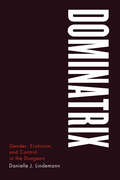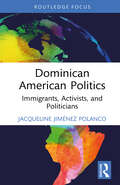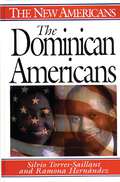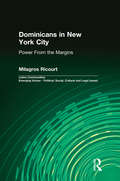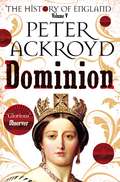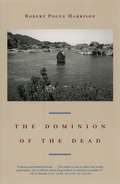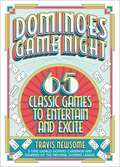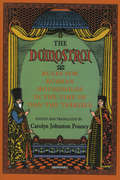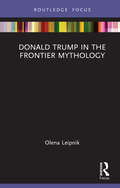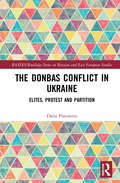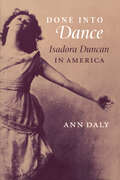- Table View
- List View
Dominatrix: Gender, Eroticism, and Control in the Dungeon
by Danielle J. LindemannOur lives are full of small tensions, our closest relationships full of struggle: between woman and man, artist and customer, purist and commercialist, professional and client—and between the dominant and the submissive. In Dominatrix, Danielle Lindemann draws on extensive fieldwork and interviews with professional dominatrices in New York City and San Francisco to offer a sophisticated portrait of these unusual professionals, their work, and their clients. Prior research on sex work has focused primarily on prostitutes and most studies of BDSM absorb pro-domme/client relationships without exploring what makes them unique. Lindemann satisfies our curiosity about these paid encounters, shining a light on one of the most secretive and least understood of personal relationships and unthreading a heretofore unexamined patch of our social tapestry. Upending the idea that these erotic laborers engage in simple exchanges and revealing the therapeutic and analytic nature of their work, Lindemann makes a major contribution to cultural studies, anthropology, and queer studies with her analysis of how gender, power, sexuality, and hierarchy shape all of our social experiences.
Dominatrix: Gender, Eroticism, and Control in the Dungeon
by Danielle J. LindemannOur lives are full of small tensions, our closest relationships full of struggle: between woman and man, artist and customer, purist and commercialist, professional and client—and between the dominant and the submissive. In Dominatrix, Danielle Lindemann draws on extensive fieldwork and interviews with professional dominatrices in New York City and San Francisco to offer a sophisticated portrait of these unusual professionals, their work, and their clients. Prior research on sex work has focused primarily on prostitutes and most studies of BDSM absorb pro-domme/client relationships without exploring what makes them unique. Lindemann satisfies our curiosity about these paid encounters, shining a light on one of the most secretive and least understood of personal relationships and unthreading a heretofore unexamined patch of our social tapestry. Upending the idea that these erotic laborers engage in simple exchanges and revealing the therapeutic and analytic nature of their work, Lindemann makes a major contribution to cultural studies, anthropology, and queer studies with her analysis of how gender, power, sexuality, and hierarchy shape all of our social experiences.
Dominatrix: Gender, Eroticism, and Control in the Dungeon
by Danielle J. LindemannOur lives are full of small tensions, our closest relationships full of struggle: between woman and man, artist and customer, purist and commercialist, professional and client—and between the dominant and the submissive. In Dominatrix, Danielle Lindemann draws on extensive fieldwork and interviews with professional dominatrices in New York City and San Francisco to offer a sophisticated portrait of these unusual professionals, their work, and their clients. Prior research on sex work has focused primarily on prostitutes and most studies of BDSM absorb pro-domme/client relationships without exploring what makes them unique. Lindemann satisfies our curiosity about these paid encounters, shining a light on one of the most secretive and least understood of personal relationships and unthreading a heretofore unexamined patch of our social tapestry. Upending the idea that these erotic laborers engage in simple exchanges and revealing the therapeutic and analytic nature of their work, Lindemann makes a major contribution to cultural studies, anthropology, and queer studies with her analysis of how gender, power, sexuality, and hierarchy shape all of our social experiences.
Dominatrix: Gender, Eroticism, and Control in the Dungeon
by Danielle J. LindemannOur lives are full of small tensions, our closest relationships full of struggle: between woman and man, artist and customer, purist and commercialist, professional and client—and between the dominant and the submissive. In Dominatrix, Danielle Lindemann draws on extensive fieldwork and interviews with professional dominatrices in New York City and San Francisco to offer a sophisticated portrait of these unusual professionals, their work, and their clients. Prior research on sex work has focused primarily on prostitutes and most studies of BDSM absorb pro-domme/client relationships without exploring what makes them unique. Lindemann satisfies our curiosity about these paid encounters, shining a light on one of the most secretive and least understood of personal relationships and unthreading a heretofore unexamined patch of our social tapestry. Upending the idea that these erotic laborers engage in simple exchanges and revealing the therapeutic and analytic nature of their work, Lindemann makes a major contribution to cultural studies, anthropology, and queer studies with her analysis of how gender, power, sexuality, and hierarchy shape all of our social experiences.
Dominatrix: Gender, Eroticism, and Control in the Dungeon
by Danielle J. LindemannOur lives are full of small tensions, our closest relationships full of struggle: between woman and man, artist and customer, purist and commercialist, professional and client—and between the dominant and the submissive. In Dominatrix, Danielle Lindemann draws on extensive fieldwork and interviews with professional dominatrices in New York City and San Francisco to offer a sophisticated portrait of these unusual professionals, their work, and their clients. Prior research on sex work has focused primarily on prostitutes and most studies of BDSM absorb pro-domme/client relationships without exploring what makes them unique. Lindemann satisfies our curiosity about these paid encounters, shining a light on one of the most secretive and least understood of personal relationships and unthreading a heretofore unexamined patch of our social tapestry. Upending the idea that these erotic laborers engage in simple exchanges and revealing the therapeutic and analytic nature of their work, Lindemann makes a major contribution to cultural studies, anthropology, and queer studies with her analysis of how gender, power, sexuality, and hierarchy shape all of our social experiences.
Dominican American Politics: Immigrants, Activists, and Politicians (Routledge Research in American Politics and Governance)
by Jacqueline Jiménez PolancoIn this book, Jacqueline Jiménez Polanco examines the politics of empowerment of Dominican Americans in the United States. Covering the first two decades of the twenty-first century, Jiménez Polanco provides a new analytical perspective to understand the political development of a growing ethnic community that has been historically neglected in the studies of Latino/a/x political development and whose peculiar characteristics represent a paradigmatic case that debunks pervading theories about immigrant communities’ participation and representation in U.S. electoral politics. Rich archival research and interviews with key Dominican American leaders and activists shed light on how some patterns followed by Dominican Americans in their political empowerment correspond to those of other Latino/a/x communities, while other patterns distinctly diverge from that common trend. Dominican American Politics: Immigrants, Activists, and Politicians serves as a perfect companion for courses on Latino/a/x and Dominican studies and U.S. ethnic politics.
Dominican American Politics: Immigrants, Activists, and Politicians (Routledge Research in American Politics and Governance)
by Jacqueline Jiménez PolancoIn this book, Jacqueline Jiménez Polanco examines the politics of empowerment of Dominican Americans in the United States. Covering the first two decades of the twenty-first century, Jiménez Polanco provides a new analytical perspective to understand the political development of a growing ethnic community that has been historically neglected in the studies of Latino/a/x political development and whose peculiar characteristics represent a paradigmatic case that debunks pervading theories about immigrant communities’ participation and representation in U.S. electoral politics. Rich archival research and interviews with key Dominican American leaders and activists shed light on how some patterns followed by Dominican Americans in their political empowerment correspond to those of other Latino/a/x communities, while other patterns distinctly diverge from that common trend. Dominican American Politics: Immigrants, Activists, and Politicians serves as a perfect companion for courses on Latino/a/x and Dominican studies and U.S. ethnic politics.
The Dominican Americans (The New Americans)
by Ramona Hernandez Silvio Torres-SaillantThis profile of Dominican Americans closes a critical gap in information about the accomplishments of one of the largest immigrant groups in the United States. Beginning with a look at the historical background and the roots of native Dominicans, this book then carries the reader through the age-old romance of U.S. and Dominican relations. With great detail and clarity, the authors explain why the Dominicans left their land and came to the United States. The book includes discussions of education, health issues, drugs and violence, the visual and performing arts, popular music, faith, food, gender, and race. Most important, this book assesses how Dominicans have adapted to America, and highlights their losses and gains. The work concludes with an evaluation of Dominicans' achievements since their arrival as a group three decades ago and shows how they envision their continued participation in American life. Biographical profiles of many notable Dominican Americans such as artists, sports greats, musicians, lawyers, novelists, actors, and activists, highlight the text.The authors have created a novel book as they are the first to examine Dominicans as an ethnic minority in the United States and highlight the community's trials and tribulations as it faces the challenge of survival in a economically competitive, politically complex, and culturally diverse society. Students and interested readers will be engaged by the economic and political ties that have attached Americans to Dominicans and Dominicans to Americans for approximately 150 years. While massive immigration of Dominicans to the United States began in the 1960s, a history of previous contact between the two nations has enabled the development of Dominicans as a significant component of the U.S. population. Readers will also understand the political and economic causes of Dominican emigration and the active role the United States government had in stimulating Dominican immigration to the United States. This book traces the advances of Dominicans toward political empowerment and summarizes the cultural expressions, the survival strategies, and the overall adaptation of Dominicans to American life.
Dominicans in New York City: Power From the Margins (Latino Communities: Emerging Voices - Political, Social, Cultural and Legal Issues)
by Milagros RicourtThis volume forms part of the Latino Communities, Emerging Voices Political, Social, Cultural and Legal Issues series. This study explores the diverse struggles of incorporation pursued by immigrants from the Dominican Republic to one city in the United States- New York City. The Dominican Republic, the second largest country of the Greater Antilles in the Caribbean Sea, was the nation that sent the most immigrants to New York City during the 1980s and 1990s. This study chronicles the lives of Dominicans in New York City: their difficulties, their courage, and their boldness to incorporate themselves into American politics.
Dominicans in New York City: Power From the Margins (Latino Communities: Emerging Voices - Political, Social, Cultural and Legal Issues)
by Milagros RicourtThis volume forms part of the Latino Communities, Emerging Voices Political, Social, Cultural and Legal Issues series. This study explores the diverse struggles of incorporation pursued by immigrants from the Dominican Republic to one city in the United States- New York City. The Dominican Republic, the second largest country of the Greater Antilles in the Caribbean Sea, was the nation that sent the most immigrants to New York City during the 1980s and 1990s. This study chronicles the lives of Dominicans in New York City: their difficulties, their courage, and their boldness to incorporate themselves into American politics.
The Dominicans in the Americas and the Philippines: Devotional Life, Catholic Literary Culture, and Models of Holiness (Routledge Studies in the History of the Americas)
by David T. Orique Rady Roldán-Figueroa Cynthia Folquer Dolores PoelzreThe Dominicans in the Americas and the Philippines (c. 1500–c. 1820) is part of a renewal of interest in the global history of the Dominican Order. Many of the essays were carefully selected among some of the papers presented at the III International Conference on the History of the Order of Preachers in the Americas, a gathering that stands in continuity with the conferences of Mexico (2013) and Bogotá (2016).This book, the contributors of which are active researchers specializing in the history of the Order of Preachers in Latin America, is organized in four parts: Women and the Order of Preachers; “Benditos Bienes”: Libraries and Material Patrimony; Missions, Devotional, and Daily Life; and The Order of Preachers and Their Writings. Contributions deal with different subfields including art history, gender studies, history of the book, and intellectual history more broadly. Additionally, it contains a chapter examining the historiography of the Order of Preachers in Latin America.Covering the time range from 1510 to the early nineteenth century, the book fills a gap in the historiography of the Order of Preachers in the Americas, especially in English-language scholarly literature. Students of Latin American history, the history of Christianity, and the history of global Catholicism will surely find the volume to be of great interest.
The Dominicans in the Americas and the Philippines: Devotional Life, Catholic Literary Culture, and Models of Holiness (Routledge Studies in the History of the Americas)
The Dominicans in the Americas and the Philippines (c. 1500–c. 1820) is part of a renewal of interest in the global history of the Dominican Order. Many of the essays were carefully selected among some of the papers presented at the III International Conference on the History of the Order of Preachers in the Americas, a gathering that stands in continuity with the conferences of Mexico (2013) and Bogotá (2016).This book, the contributors of which are active researchers specializing in the history of the Order of Preachers in Latin America, is organized in four parts: Women and the Order of Preachers; “Benditos Bienes”: Libraries and Material Patrimony; Missions, Devotional, and Daily Life; and The Order of Preachers and Their Writings. Contributions deal with different subfields including art history, gender studies, history of the book, and intellectual history more broadly. Additionally, it contains a chapter examining the historiography of the Order of Preachers in Latin America.Covering the time range from 1510 to the early nineteenth century, the book fills a gap in the historiography of the Order of Preachers in the Americas, especially in English-language scholarly literature. Students of Latin American history, the history of Christianity, and the history of global Catholicism will surely find the volume to be of great interest.
Dominion: A History of England Volume V (The History of England #5)
by Peter Ackroyd'Ackroyd makes history accessible to the layman' - Ian Thomson, IndependentThe penultimate volume of Peter Ackroyd’s masterful History of England series, Dominion begins in 1815 as national glory following the Battle of Waterloo gives way to post-war depression, spanning the last years of the Regency to the death of Queen Victoria in January 1901.In it, Ackroyd takes us from the accession of the profligate George IV whose government was steered by Lord Liverpool, who was firmly set against reform, to the reign of his brother, William IV, the 'Sailor King', whose reign saw the modernization of the political system and the abolition of slavery. But it was the accession of Queen Victoria, aged only eighteen, that sparked an era of enormous innovation. Technological progress – from steam railways to the first telegram – swept the nation and the finest inventions were showcased at the first Great Exhibition in 1851. The emergence of the middle classes changed the shape of society and scientific advances changed the old pieties of the Church of England, and spread secular ideas across the nation. But though intense industrialization brought boom times for the factory owners, the working classes were still subjected to poor housing, long working hours and dire poverty.It was a time that saw a flowering of great literature, too. As the Georgian era gave way to that of Victoria, readers could delight not only in the work of Byron, Shelley and Wordsworth but also the great nineteenth-century novelists: the Brontë sisters, George Eliot, Mrs Gaskell, Thackeray, and, of course, Dickens, whose work has become synonymous with Victorian England.Nor was Victorian expansionism confined to Britain alone. By the end of Victoria’s reign, the Queen was also an Empress and the British Empire dominated much of the globe. And, as Ackroyd shows in this richly populated, vividly told account, Britannia really did seem to rule the waves.
The Dominion of the Dead
by Robert Pogue HarrisonHow do the living maintain relations to the dead? Why do we bury people when they die? And what is at stake when we do? In The Dominion of the Dead, Robert Pogue Harrison considers the supreme importance of these questions to Western civilization, exploring the many places where the dead cohabit the world of the living—the graves, images, literature, architecture, and monuments that house the dead in their afterlife among us. This elegantly conceived work devotes particular attention to the practice of burial. Harrison contends that we bury our dead to humanize the lands where we build our present and imagine our future. As long as the dead are interred in graves and tombs, they never truly depart from this world, but remain, if only symbolically, among the living. Spanning a broad range of examples, from the graves of our first human ancestors to the empty tomb of the Gospels to the Vietnam Veterans Memorial, Harrison also considers the authority of predecessors in both modern and premodern societies. Through inspired readings of major writers and thinkers such as Vico, Virgil, Dante, Pater, Nietzsche, Heidegger, and Rilke, he argues that the buried dead form an essential foundation where future generations can retrieve their past, while burial grounds provide an important bedrock where past generations can preserve their legacy for the unborn. The Dominion of the Dead is a profound meditation on how the thought of death shapes the communion of the living. A work of enormous scope, intellect, and imagination, this book will speak to all who have suffered grief and loss.
The Dominion of the Dead (Historical Studies Of Urban America Ser.)
by Robert Pogue HarrisonHow do the living maintain relations to the dead? Why do we bury people when they die? And what is at stake when we do? In The Dominion of the Dead, Robert Pogue Harrison considers the supreme importance of these questions to Western civilization, exploring the many places where the dead cohabit the world of the living—the graves, images, literature, architecture, and monuments that house the dead in their afterlife among us. This elegantly conceived work devotes particular attention to the practice of burial. Harrison contends that we bury our dead to humanize the lands where we build our present and imagine our future. As long as the dead are interred in graves and tombs, they never truly depart from this world, but remain, if only symbolically, among the living. Spanning a broad range of examples, from the graves of our first human ancestors to the empty tomb of the Gospels to the Vietnam Veterans Memorial, Harrison also considers the authority of predecessors in both modern and premodern societies. Through inspired readings of major writers and thinkers such as Vico, Virgil, Dante, Pater, Nietzsche, Heidegger, and Rilke, he argues that the buried dead form an essential foundation where future generations can retrieve their past, while burial grounds provide an important bedrock where past generations can preserve their legacy for the unborn. The Dominion of the Dead is a profound meditation on how the thought of death shapes the communion of the living. A work of enormous scope, intellect, and imagination, this book will speak to all who have suffered grief and loss.
The Dominion of the Dead
by Robert Pogue HarrisonHow do the living maintain relations to the dead? Why do we bury people when they die? And what is at stake when we do? In The Dominion of the Dead, Robert Pogue Harrison considers the supreme importance of these questions to Western civilization, exploring the many places where the dead cohabit the world of the living—the graves, images, literature, architecture, and monuments that house the dead in their afterlife among us. This elegantly conceived work devotes particular attention to the practice of burial. Harrison contends that we bury our dead to humanize the lands where we build our present and imagine our future. As long as the dead are interred in graves and tombs, they never truly depart from this world, but remain, if only symbolically, among the living. Spanning a broad range of examples, from the graves of our first human ancestors to the empty tomb of the Gospels to the Vietnam Veterans Memorial, Harrison also considers the authority of predecessors in both modern and premodern societies. Through inspired readings of major writers and thinkers such as Vico, Virgil, Dante, Pater, Nietzsche, Heidegger, and Rilke, he argues that the buried dead form an essential foundation where future generations can retrieve their past, while burial grounds provide an important bedrock where past generations can preserve their legacy for the unborn. The Dominion of the Dead is a profound meditation on how the thought of death shapes the communion of the living. A work of enormous scope, intellect, and imagination, this book will speak to all who have suffered grief and loss.
Dominoes Game Night: 65 Classic Games to Entertain and Excite
by Travis NewsomeIn this comprehensive guide, a 3-time World Domino Champion breaks down the fascinating history and culture of one of the world's most popular pastimes—and shares how-to instructions for playing 65 different domino games. Featuring step-by-step, illustrated instructions, Dominoes Game Night will teach readers how to play 65 different domino games, including popular variations like Matador, Muggins, Chicken Foot, and Mexican Train. In addition to providing the rules of standard game play, Dominoes Game Night also delves into the 1,000+ year history and culture of the game across the world, and it looks at modern day domino tournaments that are played both in person and online. Also touching on more idiosyncratic domino uses like toppling, Dominoes Game Night introduces readers to the countless benefits of playing Dominoes—like improved memory retention and concentration—while also teaching discipline and bolstering social interactions. With a breakdown of Dominoes terms, rules, and turn-by-turn examples, this book explains the reasoning behind making specific plays, and it takes an in-depth look at the critical thinking and deductive reasoning skills that are required to master the game. Whether you're a novice who is just learning to play, or an experienced player looking to elevate your game, Dominoes Game Night offers all the tools you need to consistently win games at a higher level. Written by a 3-time World Domino Champion, Dominoes Game Night is sure to become the go-to companion for both casual players and Domino die-hards.
Dominoes Game Night: 65 Classic Games to Entertain and Excite
by Travis NewsomeIn this comprehensive guide, a 3-time World Domino Champion breaks down the fascinating history and culture of one of the world's most popular pastimes—and shares how-to instructions for playing 65 different domino games. Featuring step-by-step, illustrated instructions, Dominoes Game Night will teach readers how to play 65 different domino games, including popular variations like Matador, Muggins, Chicken Foot, and Mexican Train. In addition to providing the rules of standard game play, Dominoes Game Night also delves into the 1,000+ year history and culture of the game across the world, and it looks at modern day domino tournaments that are played both in person and online. Also touching on more idiosyncratic domino uses like toppling, Dominoes Game Night introduces readers to the countless benefits of playing Dominoes—like improved memory retention and concentration—while also teaching discipline and bolstering social interactions. With a breakdown of Dominoes terms, rules, and turn-by-turn examples, this book explains the reasoning behind making specific plays, and it takes an in-depth look at the critical thinking and deductive reasoning skills that are required to master the game. Whether you're a novice who is just learning to play, or an experienced player looking to elevate your game, Dominoes Game Night offers all the tools you need to consistently win games at a higher level. Written by a 3-time World Domino Champion, Dominoes Game Night is sure to become the go-to companion for both casual players and Domino die-hards.
The "Domostroi": Rules for Russian Households in the Time of Ivan the Terrible
by Carolyn Johnston PouncyWinner of the 1994 Heldt Prize from the Association of Women in Slavic StudiesA detailed and colorful instruction manual on household management in sixteenth-century Russia, the Domostroi gives a fascinating glimpse of the world of the nobility. This "how-to" guide is one of the few sources on the social history and secular life of Russia in the time of Ivan the Terrible. Carolyn Johnston Pouncy here offers, with an informative introduction, the first complete English translation.
Donald Trump in the Frontier Mythology (Routledge Studies in Media, Communication, and Politics)
by Olena LeipnikThis book explores the presidential image of Donald Trump as it is constructed by the media within American national mythology, precisely the frontier myth. By offering an account of three milestones in the development of the frontier mythology in its intersection with presidential imagery, the book shows how the image of Donald Trump fits into the line of "cowboy presidents," together with Theodore Roosevelt and Ronald Reagan. It also offers insights into the reasons for making Russian president Vladimir Putin a part of Trump’s story and a routinely mentioned figure in American presidential politics. Applying the means of philosophical anthropology to this topical issue at the intersection of politics and the media, this volume will appeal to those working and studying in the areas of media studies, political anthropology, American studies, and myth studies.
Donald Trump in the Frontier Mythology (Routledge Studies in Media, Communication, and Politics)
by Olena LeipnikThis book explores the presidential image of Donald Trump as it is constructed by the media within American national mythology, precisely the frontier myth. By offering an account of three milestones in the development of the frontier mythology in its intersection with presidential imagery, the book shows how the image of Donald Trump fits into the line of "cowboy presidents," together with Theodore Roosevelt and Ronald Reagan. It also offers insights into the reasons for making Russian president Vladimir Putin a part of Trump’s story and a routinely mentioned figure in American presidential politics. Applying the means of philosophical anthropology to this topical issue at the intersection of politics and the media, this volume will appeal to those working and studying in the areas of media studies, political anthropology, American studies, and myth studies.
Donald Winnicott and the Politics of Care (Studies in the Psychosocial)
by Joanna KellondThis book explores the significance of psychoanalyst Donald Winnicott’s ideas for contemporary debates about care. Locating Winnicott in relation to a range of fields, including psychology, philosophy, sociology, critical theory and feminist theory, it examines the implications of his thinking for understanding and transforming the relationship between care and society. Winnicott was unique amongst psychoanalysts for the emphasis he placed on care in the development of subjectivity. The book unpacks Winnicott’s understanding of care and assesses its relevance for conceptions of social responsibility, justice and transformation. In a world where care is in crisis, how might we theorise the conditions necessary for the development of caring subjectivities, and is it possible to infer a relationship between those conditions and progressive social change? This unique book will be of interest to readers in psychosocial studies, politics and anyone concerned with thinking about the relationship between care and social transformation.
The Donbas Conflict in Ukraine: Elites, Protest, and Partition (BASEES/Routledge Series on Russian and East European Studies)
by Daria PlatonovaThis book examines why, when the conflict in eastern Ukraine began in 2014, fighting broke out in the Donets’k region, whereas it did not in Kharkiv city, despite the city, like the Donets’k region, being geographically proximate to Russia and similar in ethnic and linguistic make up. Based on extensive original research, the book argues that a key factor was the nature and behaviour of local elites, with those in Kharkiv having diffuse ties to the centre and therefore being more capable of adapting to sudden, profound regime change at the centre, whereas the elites in the Donets’k region had much more concentrated ties to the centre, were dependent on one network, and therefore were much less able to cope with change. The book thereby demonstrates how crucial for Ukraine are patronal politics, patronage networks, and informal centre-region relations, and that it was these local political circumstances, rather than Russia, which brought about the conflict.
The Donbas Conflict in Ukraine: Elites, Protest, and Partition (BASEES/Routledge Series on Russian and East European Studies)
by Daria PlatonovaThis book examines why, when the conflict in eastern Ukraine began in 2014, fighting broke out in the Donets’k region, whereas it did not in Kharkiv city, despite the city, like the Donets’k region, being geographically proximate to Russia and similar in ethnic and linguistic make up. Based on extensive original research, the book argues that a key factor was the nature and behaviour of local elites, with those in Kharkiv having diffuse ties to the centre and therefore being more capable of adapting to sudden, profound regime change at the centre, whereas the elites in the Donets’k region had much more concentrated ties to the centre, were dependent on one network, and therefore were much less able to cope with change. The book thereby demonstrates how crucial for Ukraine are patronal politics, patronage networks, and informal centre-region relations, and that it was these local political circumstances, rather than Russia, which brought about the conflict.
Done into Dance: Isadora Duncan in America (pdf)
by Ann DalyThis cultural study of modern dance icon Isadora Duncan is the first to place her within the thought, politics and art of her time. Duncan's dancing earned her international fame and influenced generations of American girls and women, yet the romantic myth that surrounds her has left some questions unanswered: What did her audiences see on stage, and how did they respond? What dreams and fears of theirs did she play out? Why, in short, was Duncan's dancing so compelling? First published in 1995 and now back in print, Done into Dance reveals Duncan enmeshed in social and cultural currents of her time — the moralism of the Progressive Era, the artistic radicalism of prewar Greenwich Village, the xenophobia of the 1920s, her association with feminism and her racial notion of "Americanness."
